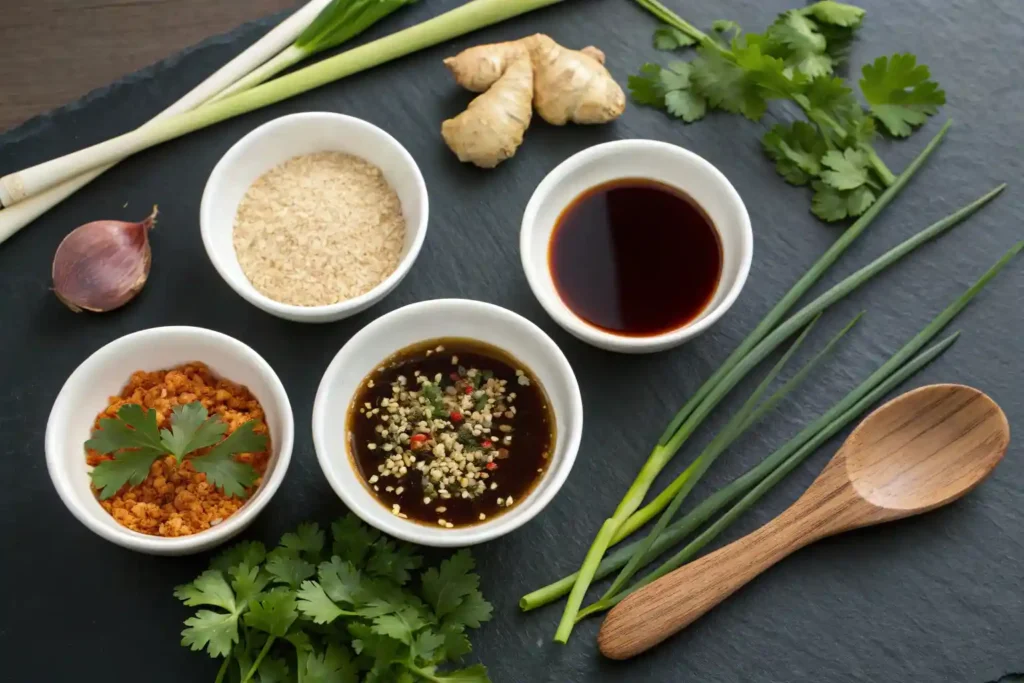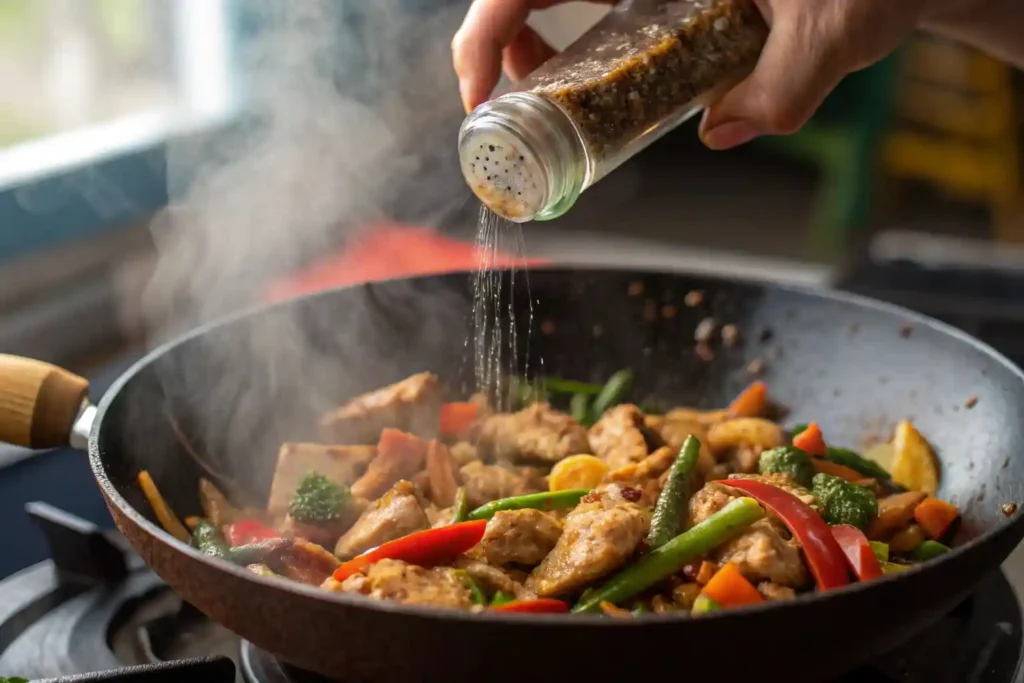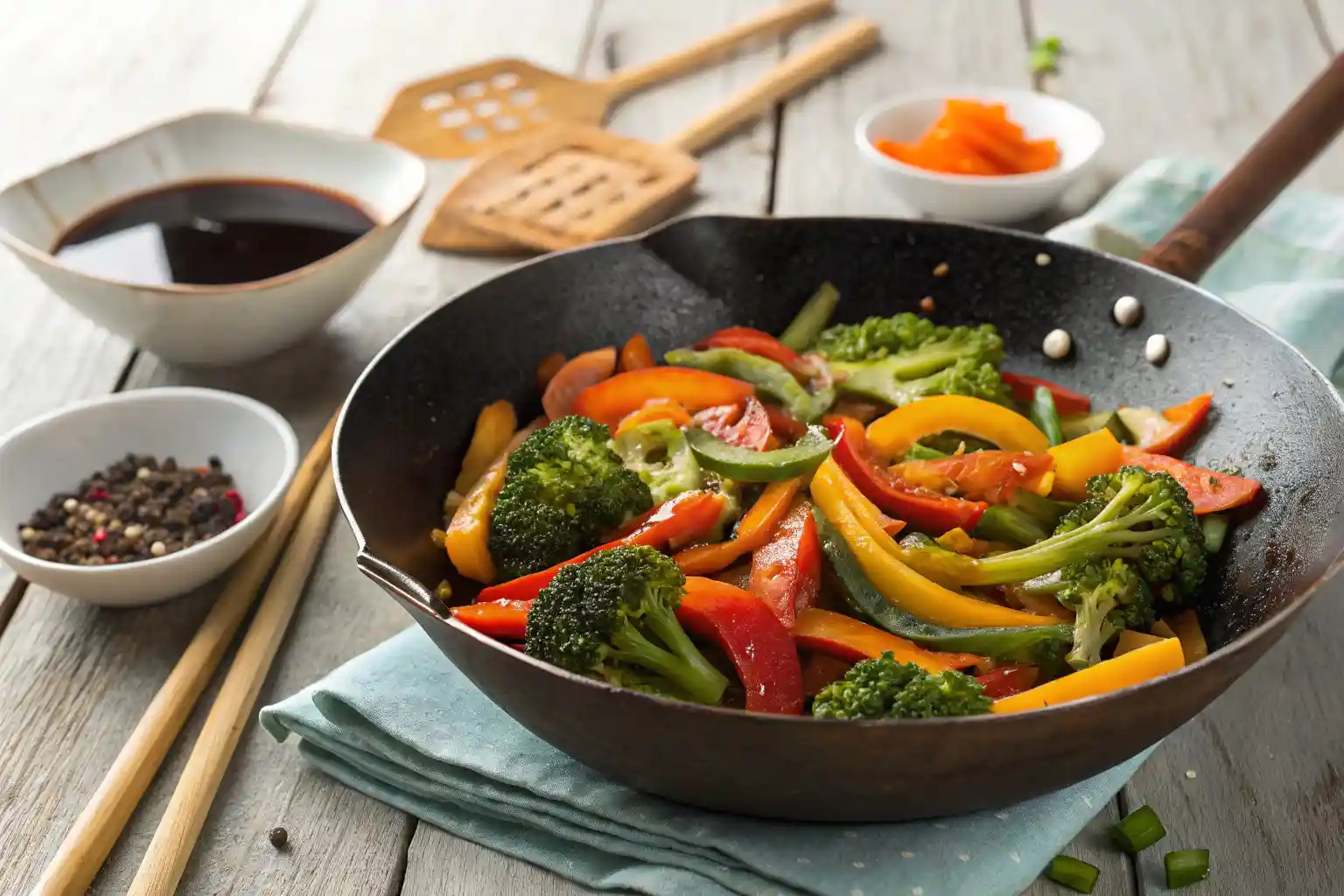Stir fry dishes are a staple in kitchens worldwide, loved for their quick preparation, vibrant flavors, and endless versatility. But what truly makes a stir fry unforgettable? The answer lies in the stir fry seasoning. This magical blend of ingredients transforms simple vegetables, proteins, and noodles into a mouthwatering masterpiece.
In this article, we’ll dive deep into everything you need to know about stir fry seasoning. From understanding its purpose to crafting your own at home, we’ll cover it all. You’ll learn about essential ingredients, tips for perfecting your seasoning, and even variations for different cuisines. By the end, you’ll be ready to whip up stir fry dishes that rival your favorite takeout. Let’s get started!
Table of contents
1: What Is Stir Fry Seasoning?
What is stir fry seasoning?
At its core, stir fry seasoning is a flavorful blend of sauces, spices, and aromatics that brings life to stir fry dishes. It’s the secret weapon that ties together the ingredients in your wok, creating a harmonious balance of salty, sweet, tangy, and umami flavors. Whether you’re cooking up a veggie-packed stir fry or a protein-rich dish, the seasoning is what makes it sing.
Stir fry flavoring typically includes a mix of liquid ingredients like soy sauce, sesame oil, and rice vinegar, combined with aromatics such as garlic and ginger. These ingredients work together to coat your stir fry in a rich, glossy sauce that clings to every bite. The result? A dish that’s bursting with flavor and impossible to resist.
The role of seasoning in stir fry dishes
Why is seasoning so important in stir fry cooking? Well, without it, your dish would taste flat and uninspired. The right stir fry flavoring enhances the natural flavors of your ingredients while adding depth and complexity. It’s what turns a handful of vegetables and a protein into a cohesive, restaurant-quality meal.
Seasoning also plays a key role in achieving the perfect texture. The combination of sauces and oils helps to caramelize your ingredients, creating that signature stir fry glaze. Plus, the aromatics infuse the dish with a tantalizing aroma that’ll have everyone running to the table.
By understanding the basics of stir fry flavoring, you’re already on your way to mastering this beloved cooking technique. In the next section, we’ll explore the key ingredients that make up the perfect seasoning blend. Stay tuned!
2: Key Ingredients for the Perfect Stir Fry
Essential ingredients for stir fry flavoring
The foundation of any great stir fry seasoning lies in its ingredients. These staples create the perfect balance of salty, sweet, tangy, and umami flavors that make stir fry dishes irresistible. Here are the must-haves:
- Soy Sauce: The backbone of most stir fry sauces, soy sauce adds a salty, umami punch. Opt for low-sodium soy sauce if you’re watching your salt intake.
- Garlic and Ginger: These aromatics are non-negotiable. Freshly minced garlic and grated ginger infuse the dish with bold, fragrant flavors.
- Sesame Oil: A drizzle of toasted sesame oil adds a nutty depth that elevates the entire dish.
- Rice Vinegar: This mild vinegar provides a subtle tanginess that balances the richness of the other ingredients.
- Brown Sugar or Honey: A touch of sweetness rounds out the flavors and helps create that signature glossy sauce.
Optional ingredients for unique flavors
Want to take your stir fry flavoring to the next level? Experiment with these optional ingredients to customize your dish:
- Oyster Sauce: Adds a rich, savory depth that’s perfect for meat-based stir fries.
- Hoisin Sauce: A sweet and tangy addition that pairs beautifully with vegetables and tofu.
- Chili Paste or Sriracha: For those who love a spicy kick, these ingredients bring the heat.
- Fish Sauce: Just a dash can add a complex umami flavor, especially in Thai-inspired stir fries.
The seven common ingredients in a stir fry
If you’re wondering what the seven most common ingredients in a stir fry are, here’s the list: soy sauce, garlic, ginger, sesame oil, rice vinegar, sugar (or honey), and cornstarch (for thickening). These ingredients form the base of most stir fry recipes and can be adjusted to suit your taste.
By understanding these key ingredients, you’re well on your way to creating a stir fry seasoning that’s both versatile and delicious. In the next section, we’ll show you how to bring these ingredients together to make your own seasoning at home.
3: How to Make stir fry flavoring at Home

Step-by-step guide to making stir fry flavoring
Making your own stir fry seasoning at home is easier than you think! Here’s a simple recipe to get you started:
- Gather Your Ingredients: Combine 1/4 cup soy sauce, 1 tablespoon sesame oil, 1 tablespoon rice vinegar, 1 tablespoon brown sugar, 2 minced garlic cloves, and 1 teaspoon grated ginger in a bowl.
- Mix Well: Whisk the ingredients together until the sugar dissolves completely.
- Thicken the Sauce: If you prefer a thicker sauce, mix 1 teaspoon of cornstarch with 2 tablespoons of water, then stir it into the seasoning.
This basic recipe is a great starting point, but feel free to tweak it to suit your preferences. Add chili paste for heat, hoisin sauce for sweetness, or fish sauce for extra umami.
How to store homemade stir fry flavoring
Once you’ve made your stir fry flavoring, proper storage is key to maintaining its freshness. Transfer the sauce to an airtight container or jar and refrigerate it. It should last for up to a week. If you’ve added fresh ingredients like garlic or ginger, use it within 3-4 days to ensure the best flavor.
For longer storage, consider freezing the seasoning in ice cube trays. This way, you can pop out a portion whenever you need it!
Secret ingredients to elevate your stir fry flavoring
Want to make your stir fry truly unforgettable? Try adding one of these secret ingredients:
- Miso Paste: A small spoonful adds a deep, savory flavor that’s hard to beat.
- Peanut Butter: Perfect for Thai-inspired stir fries, peanut butter adds creaminess and a nutty richness.
- Coconut Milk: For a tropical twist, use coconut milk to create a creamy, flavorful sauce.
By following these steps, you’ll have a homemade stir fry flavoring that’s not only delicious but also tailored to your taste. Ready to put it to use? In the next section, we’ll share tips for using your seasoning to create the perfect stir fry.
4: Tips for Cooking with Stir Fry Flavors

How to use stir fry flavoring for the best results
Using stir fry seasoning effectively can make or break your dish. The key is knowing when and how to add it during the cooking process. Here’s a simple guide to ensure your stir fry turns out perfect every time:
- Cook Your Ingredients First: Start by stir-frying your vegetables and proteins in a hot wok or skillet with a bit of oil. This ensures they’re cooked evenly and retain their texture.
- Add the Seasoning at the Right Time: Once your ingredients are nearly cooked, pour in your stir fry flavoring. This prevents the sauce from burning and allows it to coat the ingredients evenly.
- Simmer for a Few Minutes: Let the seasoning simmer for 1-2 minutes to thicken and develop its flavors. If you’ve added cornstarch, this is when the sauce will achieve that glossy finish.
By following these steps, you’ll ensure that your stir fry is flavorful, well-coated, and perfectly cooked.
How to make stir fry more flavorful
If you want to take your stir fry to the next level, there are a few tricks you can try:
- Marinate Your Protein: Before cooking, marinate your chicken, beef, or tofu in a small amount of the stir fry seasoning. This infuses the protein with flavor from the inside out.
- Deglaze the Pan: After cooking your ingredients, add a splash of water or broth to the pan before adding the seasoning. This helps lift any caramelized bits stuck to the bottom, adding extra depth to your sauce.
- Layer Your Flavors: Don’t rely solely on the seasoning. Add fresh aromatics like garlic, ginger, or green onions during cooking to enhance the overall taste.
Common mistakes to avoid when using stir fry flavoring
Even the best stir fry flavoring can fall flat if used incorrectly. Avoid these common pitfalls:
- Over-Salting: Be mindful of the salt content in your ingredients, especially if you’re using soy sauce or other salty condiments. Taste as you go to avoid over-seasoning.
- Burning the Sauce: Stir fry sauces cook quickly, so keep an eye on the heat. High heat is great for stir-frying, but too much can scorch the sauce.
- Using Too Much Oil: While oil is essential for stir-frying, too much can make your dish greasy and dilute the flavor of the seasoning.
5: Variations of stir fry flavoring for Different Cuisines
Asian-inspired stir fry flavoring variations
Asian cuisine offers a treasure trove of flavor profiles, and your stir fry seasoning can be easily adapted to match. Here are a few ideas:
- Chinese-Style: Add oyster sauce, Shaoxing wine, and a pinch of white pepper for a classic Chinese stir fry.
- Thai-Style: Incorporate fish sauce, lime juice, and a touch of palm sugar for a sweet and tangy twist.
- Japanese-Style: Use soy sauce, mirin, and a dash of sake for a light, umami-rich seasoning.
These variations allow you to explore different cuisines without leaving your kitchen.
Western-style stir fry flavoring ideas
If you’re looking for a more Western take on stir fry, try these seasoning ideas:
- Herb-Infused: Add dried herbs like basil, oregano, or thyme to your seasoning for a Mediterranean-inspired dish.
- Creamy Twist: Mix in a dollop of Dijon mustard or a splash of cream for a rich, indulgent sauce.
- Smoky Flavor: Use smoked paprika or chipotle powder to add a bold, smoky kick.
These options are perfect for experimenting with new flavors and keeping your meals exciting.
Vegan and gluten-freestir fry flavoring options
For those with dietary restrictions, it’s easy to make your stir fry seasoning vegan or gluten-free:
- Soy Sauce Alternatives: Use tamari or coconut aminos instead of regular soy sauce for a gluten-free option.
- Vegan Substitutes: Replace oyster sauce with mushroom sauce or hoisin sauce for a plant-based alternative.
By tailoring your seasoning to your dietary needs, you can enjoy delicious stir fry dishes without compromise.
6: FAQs About Stir Fry Seasoning
What is the best way to store stir fry flavoring?
The best way to store stir fry seasoning depends on whether it’s homemade or store-bought. For homemade seasoning, transfer it to an airtight container or jar and refrigerate it. It will stay fresh for up to a week, especially if it contains fresh ingredients like garlic or ginger. If you want to extend its shelf life, freeze it in small portions using an ice cube tray. This way, you can defrost just the amount you need for your next stir fry.
Store-bought stir fry sauces, on the other hand, should be kept in a cool, dry place until opened. Once opened, refrigerate them and check the label for specific storage instructions.
Can I make stir fry seasoning without soy sauce?
Absolutely! If you’re avoiding soy sauce due to dietary restrictions or personal preference, there are plenty of alternatives. Coconut aminos is a popular substitute that offers a similar salty, umami flavor but with less sodium. Tamari is another great option, especially for those who need a gluten-free alternative. You can also experiment with liquid aminos or even a mix of miso paste and water for a unique twist.
How do I thicken stir fry flavoring?
To thicken your stir fry seasoning, mix 1 teaspoon of cornstarch with 2 tablespoons of water to create a slurry. Add this mixture to your stir fry during the final minutes of cooking, and let it simmer until the sauce thickens. Arrowroot powder or tapioca starch can also be used as gluten-free thickening agents.
Can I use stir fry seasoning for other dishes?
Yes! Stir fry seasoning is incredibly versatile. Use it as a marinade for proteins, a dipping sauce for dumplings, or even as a glaze for roasted vegetables. Its bold flavors work well in a variety of dishes, making it a handy addition to your kitchen arsenal.
Conclusion
Mastering the art of making and using stir fry flavoring is a game-changer for anyone who loves quick, flavorful meals. With its perfect balance of salty, sweet, tangy, and umami flavors, this seasoning can transform simple ingredients into a restaurant-quality dish. Whether you’re preparing a classic Asian stir fry or experimenting with unique variations, the possibilities are endless.
For more inspiration, check out our Seafood Boil Sauce Recipe to explore another versatile and flavorful sauce that can elevate your cooking. Additionally, if you’re looking for more ideas on how to customize your stir fry flavoring, this guide to stir fry seasoning offers excellent tips and recipes to try at home.
By incorporating these tips and resources, you’ll be well-equipped to create delicious, personalized stir fry dishes that suit your taste and dietary preferences. So grab your wok, experiment with flavors, and enjoy the endless possibilities of stir fry cooking!

